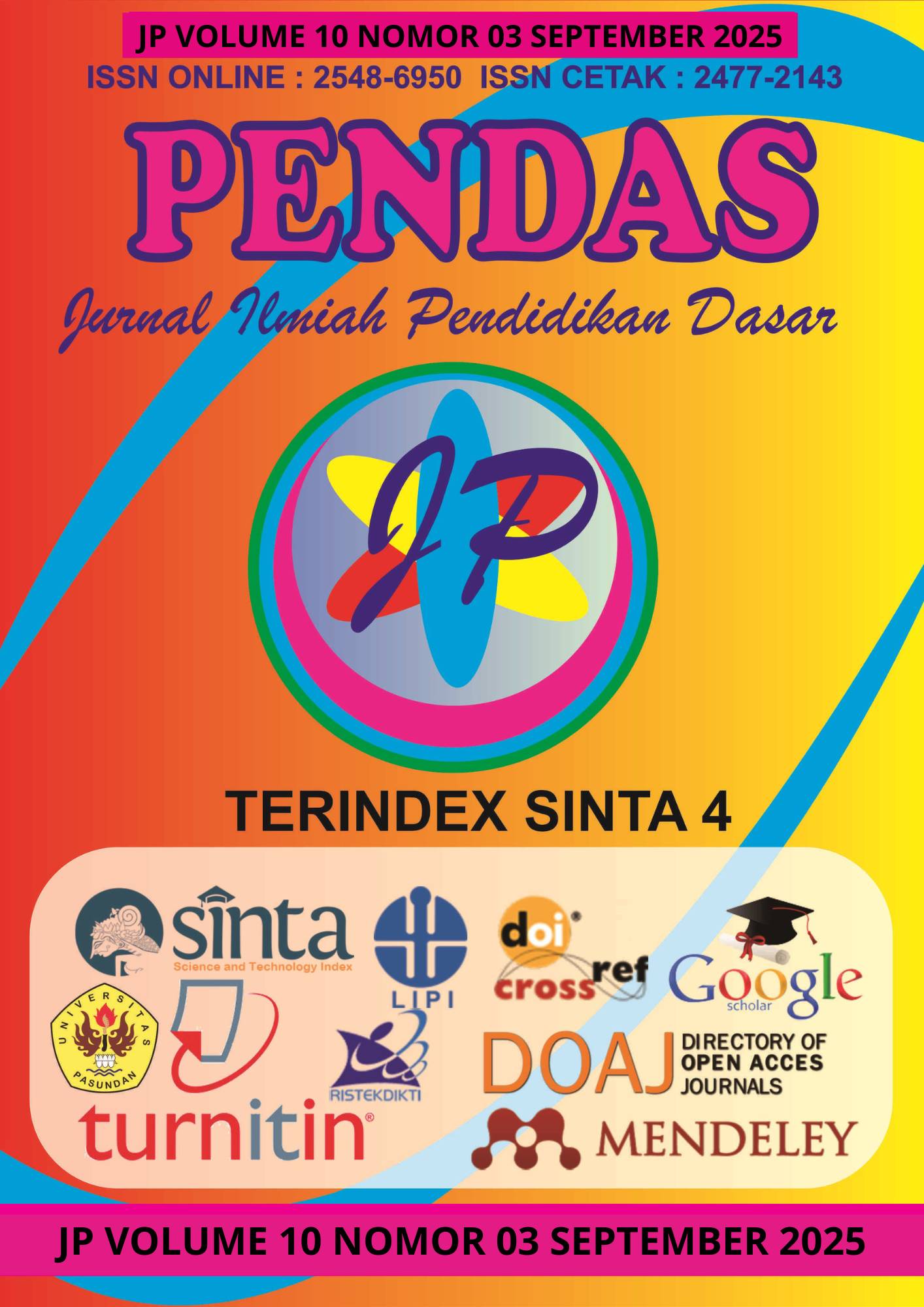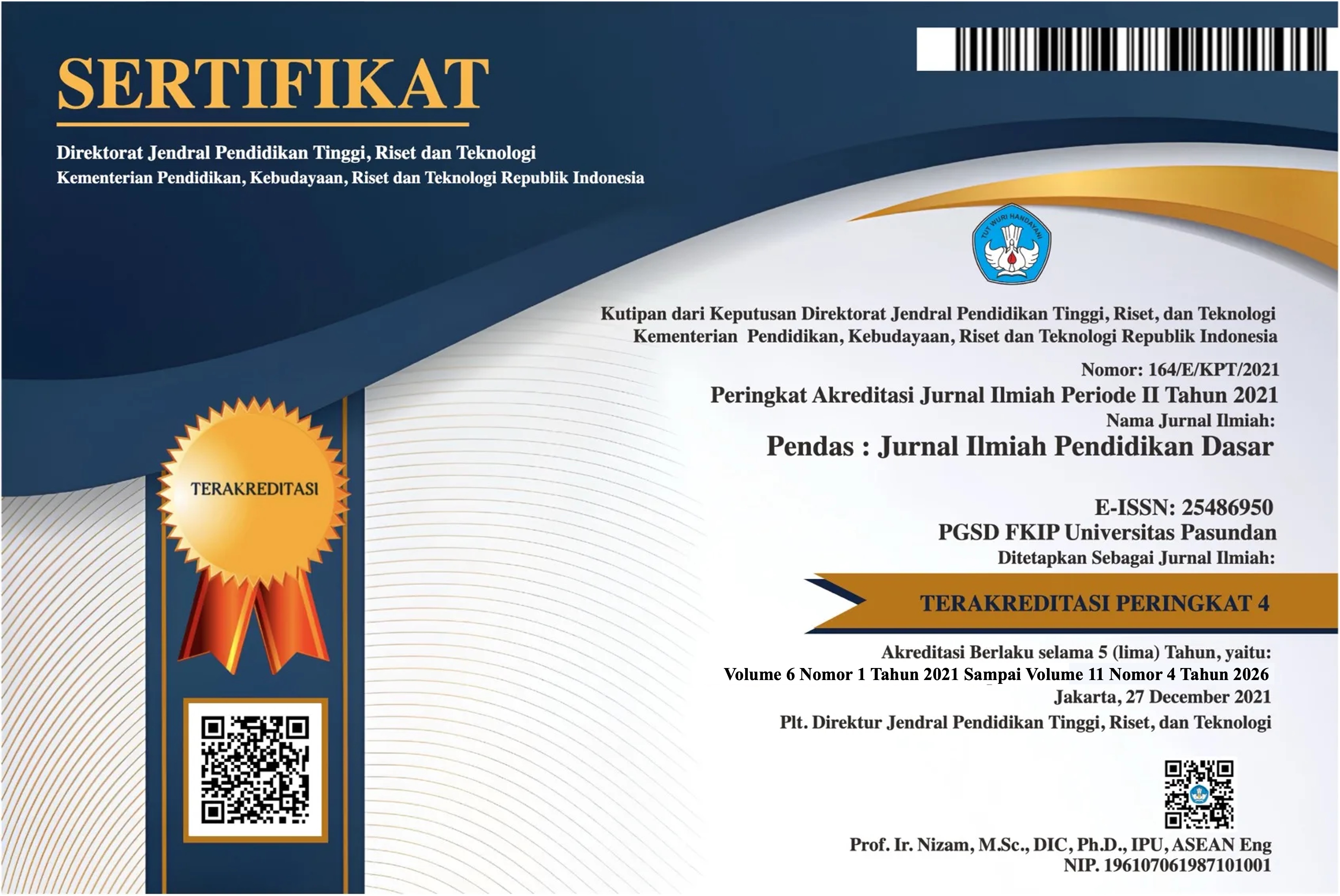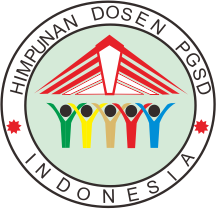EFEKTIVITAS ORIENTEERING DALAM MENINGKATKAN DAYA BERPIKIR SPASIAL PADA KEMAMPUAN BERNAVIGASI DI SD NEGERI 2 TAMBAK BAYA
DOI:
https://doi.org/10.23969/jp.v10i03.32276Keywords:
spatial thinking skills, orienteering, elementary childrenAbstract
Spatial ability, which is included in one of the multiple intelligences, is an ability that is considered as important as linguistic intelligence in most literature. Spatial ability, which is closely related to geometry, is also connected to navigational ability. Map or plan reading lessons through Orienteering support experiential learning which is considered more effective because learning is centered on students. The quasi-experimental research method used in this study was carried out at Grade 3 SD Negeri 2 Tambak Baya on 55 students consisting of 27 students in the control group and the remaining 28 in the experimental group. The study took place in 3 meetings. The research data were taken based on the Spatial Thinking Skill Test (STST) aspect indicators whose instruments were modified and developed into action tests that were delivered verbally but contained definite answers like answer keys. The results of the study revealed that there was an increase in student learning outcomes through the application of orienteering as seen from the average comparison test of the pre-test of 35.48 with the post-test learning outcomes of 78.81. From the results of the N-gain statistical test, it was found that orienteering was quite effective in improving spatial thinking skills which were useful for students' navigation skills with an N-gain score of 70.03%. Different results were also found between male and female students in the application of orienteering in the experimental class based on a comparison of the average post-test learning outcomes. From the results of this study, it can be concluded that the application of orienteering is quite effective in developing students' thinking skills. Orienteering can be recommended as a teaching method in Social Natural Sciences lessons because it is a fun activity because learning is centered on students which is done through experience so that the application of spatial thinking skills can be applied in everyday life. This is also relevant to the current independent curriculum which uses a deep learning approach.
Downloads
References
Afriyanti, Nofia. (2019). Hubungan Kecerdasan Visual Spasial terhadap Hasil Belajar Matematika Materi Bangun Datar Siswa Kelas IV Sekolah Dasar MI Al-Khoiriyah 01 Semarang Tahun Ajaran 2018/2019. Fakultas Ilmu Tarbiyah dan Keguruan Universitas Islam Negeri Walisongo Semarang. Semarang. https://eprints.walisongo.ac.id/id/eprint/9750/1/NOFIA%20AFRIYANTI_1403096002.pdf
Ainsworth, E., Shaaron, & Schriter, Katharina. (2021). Learning by Drawing Visual Representations: Potential, Purpose, and Practical Implication. Association for Psychological Science, 30(1): 61-67. DOI: 10.1177/0963721420979582
Aklimawati, & Mahmuzah, Rifaatul. (2017). Korelasi Kecerdasan Spasial Terhadap Mathematical Proficiency Siswa Sekolah Dasar Kota Banda Aceh. Jupendas: Jurnal Pendidikan Dasar, 4(2): 1-6. http://jfkip.umuslim.ac.id/index.php/jupendas/article/view/309
Ayuldeş, Murat, & Akbaş, Yavuz. (2023). The Effect of Orienteering on the Sixth-Grade Students' Academic Achievement and Map Literacy. Education and Science, 48(213): 113-142. DOI: 10.15390/EB.2023.11528
Badan Standar, Kurikulum, dan Asesmen Pendidikan. (2022). Capaian Pembelajaran Mata Pelajaran Ilmu Pengetahuan Alam dan Sosial (IPAS) Fase A – Fase C untuk SD/MI/Program Paket A. Kementerian Pendidikan, Kebudayaan, Riset, dan Teknologi Republik Indonesia. https://kurikulum.kemdikbud.go.id/file/cp/dasmen/13.%20CP%20IPAS.pdf
Batista, M., M., dkk. (2020). Physiological and cognitive demands of orienteering: a systematic review. Sport Science and Health. Springer-Verlag Italia. 16(7592): 591–600. DOI: 10.1007/s11332-020-00650-6
Berliana, D., & Atikah, C. (2023). Teori Multiple Intelligences dan Implikasinya dalam Pembelajaran. Jurnal Citra Pendidikan, 3(3):1108-1117. DOI: 10.38048/jcp.v3i3.963
Brink, Vd., D., & Janzen, G. (2013). Visual spatial cue use for guiding orientation in two-to-three-year-old children. Frontiers in Psychology, 4(904): 1-12. https://doi.org/10.3389/fpsyg.2013.00904
Carniel, A., C. (2024). Defining and designing spatial queries: the role of spatial relationships. Geo-Spatial Information Science, 27(6): 1868-1892. DOI: 10.1080/10095020.2022.2163924
Clark, Carol. (2019). Gender Gap in Spatial Seasoning Starts in Elementary School, Meta-Analysis Finds. Emory University: Emory News Center. https://news.emory.edu/stories/2019/04/esc_gender_gap_spatial_reasoning/campus.html
Creswell, John, & Crewell, David. (2023). Research Design: Qualitative, Quantitative, and Mixed-Methode Approach 6th Edition. SAGE Publications, Inc. https://books.google.co.id/books?id=Rkh4EAAAQBAJ&printsec=frontcover&hl=id#v=onepage&q&f=false
Dandenong Ranges Orienteering Club. "Orienteering History". Momentech Software Services. Archived from the original on 2006-01-08. Retrieved 2006-02-19. https://web.archive.org/web/20060108211727/http://www.momentech.com.au/droc/HistoryOrienteering.asp
Dewey, John. (1916). Democracy and Education: An Introduction of Philosophy Education. The Free Press. https://books.google.co.id
Dewey, John. (2001). Democracy and Education: A Penn State Electronic Classics Series Publication. Pennsylvania State University. https://nsee.memberclicks.net/assets/docs/KnowledgeCenter/BuildingExpEduc/BooksReports/10.%20democracy%20and%20education%20by%20dewey.pdf
Duffy, G., dkk. (2025). Spatial Ability in STEM Learning. Frontiers in Education. DOI: 10.3389/feduc.2025.1602013
Fitri, Amalia, dkk. (2022). Buku Panduan Guru Ilmu Pengetahuan Alam dan Sosial. Kementerian Pendidikan, Kebudayaan, Riset, dan Teknologi Republik Indonesia. https://static.buku.kemdikbud.go.id/content/pdf/bukuteks/kurikulum21/IPAS-BG-KLS-VI.pdf
Fraenkel, J., Wallen, N., & Hyun, H. (1993). How to Design and Evaluate Research in Education 10th ed. McGraw-Hill Education. https://saochhengpheng.wordpress.com/wp-content/uploads/2017/03/jack_fraenkel_norman_wallen_helen_hyun-how_to_design_and_evaluate_research_in_education_8th_edition_-mcgraw-hill_humanities_social_sciences_languages2011.pdf
Gardner, Howard. (2011). Frames of Mind: The Theory of Multiple Intelligence. Basic Books. (Buku pertama diterbitkan pada 1983). https://lib.ui.ac.id/detail?id=20113111&lokasi=lokal
Gillian, A. Kattie. (2020). Make Space: The Important of Spatial Thinking In Learning Mathematics. Frontiers for Young Mind, 8(50): 1-8. DOI: 10.3389/frym.2020.00050
Græsli, J., Anders. (2024). How can children best learn map skills? a step-by-step approach. European Early Childhood Education Research. Education Research Association, 32(5): 909-924. DOI: 10.1080/1350293X.2024.2322528
International Orienteering Federation. (2024). Competition rules for International Orienteering Federation: Foot Orienteering Event. Official IOF Web Site. https://orienteering.sport/wp-content/uploads/2024/05/iof-rules-2024-v1.12.pdf
Khasan, A. (2025). Tantangan Minat Baca Siswa SD di Era Digital: Potret Pendidikan Indonesia. Dinas Perpustakaan Dan Kearsipan Provinsi Banten. https://dpk.bantenprov.go.id/berita/budaya-literasi-dalam-keluarga
Listyani, P. Ayu., & Grecila, M. (2019). Perancangan Media Informasi Olahraga Orienteering.Universitas Multimedia Nusantara. https://kc.umn.ac.id/id/eprint/10180
Luthfi, M., & Rasimin. (2023). Effectiveness of Orienteering Game Based On Google Maps in Scouting Activities, To Grow The Social Character of Students. Afeksi: Jurnal Penelitian dan Evaluasi Pendidikan, 4(5): 482-492. DOI: 10.35672/afeksi.v4i5.150
Mardiyah, H., & Munowati, Fauzi. (2017). Hubungan Kecerdasan Spasial Terhadap Hasil Belajar Matematika Bangun Ruang Siswa Kelas 5 SD Negeri 5 Banda Aceh. Jurnal Ilmiah Pendidikan Guru Sekolah Dasar FKIP Unsyiah, 2(1): 48-60. DOI: 10.24815/primary.v2i1.4393
Maresch, Günter, & Sorby A. Sheryl. (2021). Perspective on Spatial Thinking. Journal for Geometry and Graphics, 25(2): 271-293. https://www.researchgate.net/publication/365464491
Mawarni, L., Ahyuni (2025). The Use of Map Media: A Study of Spatial Thinking Skills. Science Education and Aplication Journal. Universitas Islam Lamongan, 7(1):77-86. DOI: http://dx.doi.org/10.30736/seaj.v7i1.1193
Raharjo. (2021). Tutorial SPSS, Uji Asumsi Dasar, Uji Asumsi Klasik: Cara Melakukan Uji Normalitas Kolmogorov-Smirnov dengan SPSS. SPSS Indonesia. https://www.spssindonesia.com/2015/05/cara-uji-normalitas-shapiro-wilk-dengan.html
Reese, H., W. (2011). The Learning-by-Doing Principle. Behavioral Development Bulletin, 17(1): 1-19. DOI: 10.1037/h0100597
Sari, A., P., et al. (2024). Uji Normalitas dan Homogenitas dalam Analisis Statistik. Jurnal Pendidikan Tambusai, 8(3): 51329-51337. ISSN: 2614-3097. https://jptam.org/index.php/jptam/article/download/24059/16348/40756
Shepard, R. N., & Metzler, J. (1971). Mental rotation of three-dimensional objects. Science, 171(3972): 701-703. DOI: 10.1126/science.171.3972.701.
Tore, P., A., D. (2016). Spatial navigation cognitive strategies, perspective taking and Special Educational Needs: re-thinking orienteering sport in complexity. Journal of Physical Education and Sport, 16(2): 476 - 480. DOI: 10.7752/jpes.2016.02073
Williams, K., Morgan. (2017). John Dewey in The 21st Century. Journal of Inquiry & Action in Education, 9(1). ISSN: 2159-1474
YİĞİT, Turan, & KARATEKİN, Kadir. (2021). The Effect of Orienteering Application on Student’s Spatial Thinking Skills in Social Studies: The Case of Turkey. Review of International Geographical Education, 11(1). DOI: 10.33403/rigeo.839193
Savitri, Devita. (2024). Mendikdasmen: Deep Learning Ful-ful Bukan Kurikulum tapi Pendekatan Belajar. Detik.com. https://www.detik.com/edu/sekolah/d-7630408/mendikdasmen-deep-learning-ful-ful-bukan-kurikulum-tapi-pendekatan-belajar
Downloads
Published
Issue
Section
License
Copyright (c) 2025 Pendas : Jurnal Ilmiah Pendidikan Dasar

This work is licensed under a Creative Commons Attribution 4.0 International License.



















